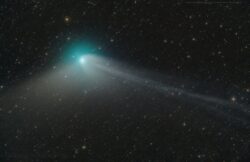Comet ZTF can still be found with binoculars or a small telescope and a good sky map (Picture: Reuters)
A rare, green comet not seen in the night sky since the time of the Neanderthals made an appearance in the sky this month.
It’s nearly time to bid farewell as C/2022 E3 (ZTF) gets fainter in the sky as it zooms away. However, there is still time to see it if you look in the right place.
Geometrically, Comet ZTF has passed its closest to both the Sun and the Earth and is now headed back to the outer solar system.
Its orbit around the Sun had it gliding across the northern sky all month, after passing near Polaris and both the Big and Little Dippers last month.
Now below naked-eye visibility, Comet ZTF can be found with binoculars or a small telescope and a good sky map.
A good time to see the comet over the next week is after the Sun sets but before the Moon rises.
The comet was photographed between the two dippers in late January while sporting an ion tail that extended over 10 degrees.
Identified last year, the comet last blazed overhead 50,000 years ago and astronomers say it’ll never be seen above Earth again.
The comet, with its distinctive green coma (the cloud of gas surrounding the icy rock core), passed around the sun in early January and was now on its way back out to space.
Many took advantage of the fact that the comet C/2022 E3 could be seen with the naked eye and shared their images on social media.
People used apps like SkyPortal and Stellarium that pinpointed C/2022 E3 (ZTF) on a star map.
Other skywatchers and amateur astronomers posted pictures and videos of the comet. People with specialist telescopes and binoculars were rewarded with a better view.
However, Londoners hoping to spot the comet were met with disappointment as cloudy conditions hindered their view.
It was the first time the comet had appeared over Stonehenge in the UK, as the last time the space rock was visible from Earth was around 50,000 years ago, long before the stone circle was built.
The comet reached its brightest around February 1, its closest approach to Earth as it swings out of the solar system after it’s orbit around the sun.
The comet – called E3 for short – was first spotted by the Zwicky Transient Facility on March 2 this year.
At its closest, it came within roughly 26 million miles of the earth. That’s equivalent to more than 109 times the average distance between the Earth and the moon.
MORE : Second chance to see green comet that won’t visit for another 50,000 years
MORE : Green comet C/2022 E3 is visible in the night sky above the UK tonight
Comet ZTF can still be found with binoculars and a good sky map.





